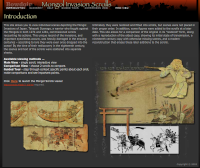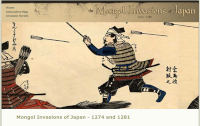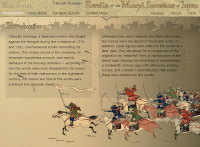Mongol Invasions of Japan - 1274 and 1281
This web site is devoted to understanding the Mongol Invasions of Japan in 1274 and 1281. The failure of the invasions gave rise to the notion of the "divine wind" or Kamikaze, although an exploration of the invasions reveals that the Japanese defeated the Mongols with little need of divine, or meteorological intervention.
Explore scrolls commissioned by Takezaki Suenaga, one of the warriors who fought against the Mongols in 1274 and 1281. Take a guided tour explaining how these Scrolls of the Mongol Invasions of Japan were altered, or read the scrolls in tandem with a translation (here the 19th century version is best). Interactive maps depicting the invasions of 1274, when the Mongols landed in Northern Kyushu, and the 1281 campaign, which was fought mostly on islands and the high seas.
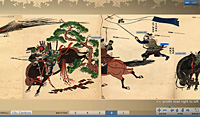 Takezaki Suenaga's Scrolls of the Mongol Invasions of Japan:
Takezaki Suenaga's Scrolls of the Mongol Invasions of Japan:
Interactive scroll viewer allowing comparisons of historical copies of the ancient invasion scrolls.
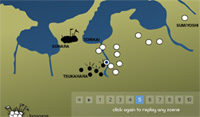 Mongol Invasions of Japan - Interactive Maps:
Mongol Invasions of Japan - Interactive Maps:
A timeline and map detailing the invasions of the Mongol forces and the Japanese defense.
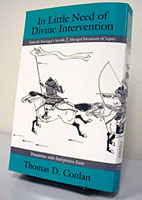 In Little Need of Divine Intervention: Scrolls of the Mongol Invasions of Japan.
In Little Need of Divine Intervention: Scrolls of the Mongol Invasions of Japan.
Cornell East Asia Series, August 2001 (Currently in third printing).
by Thomas D. Conlan, Associate Professor of History and Asian Studies.
In Little Need of Divine Intervention presents a fundamental revision of the thirteenth-century Mongol Invasions of Japan by revealing that the warriors of medieval Japan were capable of fighting the Mongols to a standstill without the aid of any "divine winds" or kamikaze.
Thomas Conlan gave a lecture entitled From Ad Hoc to Ongoing: The Mongol Invasions and the Institutionalization of Authority of Japan for the one-day conference "The Mongols from the Margins: New Perspectives on Central Asians in World History” at UCLA on February 22, 2013. Listen to it here
For Thomas Conlan’s research on how the Mongol Scrolls were altered in the eighteenth century, with the addition of Mongol Warriors and an exploding shell (teppō) at a later date, read his: Myth, Memory and the Scrolls of the Mongol Invasions of Japan. Elizabeth Lillehoj, ed. Archaism and Antiquarianism in Korean and Japanese Art (Chicago: Center for the Art of East Asia, University of Chicago and Art Media Resources, 2013), pp. 54-73.

